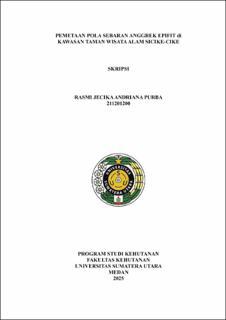| dc.description.abstract | Epiphytic orchids (Orchidaceae) are non-parasitic plants that grow attached to
trees and play a vital role in maintaining the balance of tropical forest ecosystems.
Their growth is highly influenced by microhabitat factors such as humidity, light
intensity, temperature, and the structure of host trees. In Indonesia, epiphytic
orchid diversity is high, yet specific data regarding their spatial distribution in the
Sicike-cike Nature Park (TWA Sicike-cike) remain limited. This study aimed to
identify the natural distribution patterns and map the spatial distribution of
epiphytic orchids in the area. The research was conducted using 70 plots measuring
20 × 20 meters, with coordinate recording via Avenza Maps and spatial analysis
using ArcGIS. Results indicated that the distribution pattern of epiphytic orchids
was clumped, as reflected by the Morisita Index (>1), with Bulbophyllum uniflorum
identified as the dominant species. Their spatial distribution was uneven and
concentrated in areas with moderate vegetation cover, high humidity, and
elevations favorable for optimal growth. Most species were found on the lower to
middle zones of host tree trunks (zones 1 and 2), which provided the most suitable
microclimatic conditions. This spatial mapping highlights the ecological
importance of TWA Sicike-cike as a conservation area for epiphytic orchids and
supports spatial approaches in biodiversity management. | en_US |


